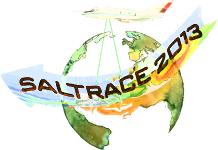News
Overview paper published
The early online release of the SALTRACE overview paper is now available via the BAMS journal homepage.
Dec 2016
New publications
Check out recent SALTRACE publications on out Publications page.
Jul 2016
New publications
Check out recent SALTRACE publications on out Publications page.
Jul 2016
SALTRACE@DUST2016
Session MF09 - Atmospheric Transport and Modification of Mineral Dust.
See DUST2016 Website for details.
11 Mar 2016
4th SALTRACE Workshop
Our 4th workshop was be held at DLR (Oberpfaffenhofen) from Nov 30 to Dec 1,
2015.
1 Dec 2015
SALTRACE
Special Issue
We are pleased to inform you that AMT and ACP have approved our proposal for a joint Inter-Journal Special Issue about SALTRACE. As of today, manuscripts can be submitted by using the online registration forms on the ACP and AMT websites. The SALTRACE Special Issue is open until 28 February 2017. 16 Feb 2015
SALTRACE at EGU 2015
Please note the session at the EGU General Assembly 2015 in Vienna Intercontinental transport of mineral dust across the Atlantic Ocean where various groups will present first data and results from SALTRACE.19 Jan 2015
3rd SALTRACE workshop
The 3rd SALTRACE data workshop was held on Feb 24 and 25, 2015 at the LMU in Munich. 25 Feb 2015
2nd SALTRACE workshop
Our second SALTRACE workshop was held in Leipzig from May 27 to 28th to exchange first results of the SALTRACE data analysis between the different groups. 30 May 2014
Instrumentation
Instrumentation on board the DLR Falcon for SALTRACE
| Aerosol in-situ instruments operated inside the cabin behind an isokinetic inlet (Dp < 2.5 μm) | |
| Multi-channel CPC (2 unheated, 2 heated channels) | Integral number concentration of ultrafine particles (0.004 μm < Dp < 2.5 μm) and non-volatile particle fraction |
| 2-channel OPC (Grimm SKY-OPC 1.129) | Total and non-volatile size distribution (0.25 μm < Dp < 2.5 μm) |
| Thermo-denuder (250°C) + CPC | Size distribution non-volatile/total Aitken mode (0.01 μm < Dp < 2.5 μm) |
| 3-λ-PSAP | Absorption coefficient at λ=467 nm, λ=530 nm and λ=660 nm |
| SP2 | Black carbon mass, single-particle coating thickness, mixing state |
| CCNC | Fraction of aerosol particles acting as cloud condensation nuclei as function of supersaturation |
| Impactor sampler | Chemical composition and shape of fine mode particles |
| Aerosol in-situ instruments sampling at wing stations | |
| UHSAS-A | Aerosol size distributions (nominal size range: 60 nm < Dp < 1 μm) |
| PCASP-100X | Dry state accumulation mode (nominal size range: 0.12 μm < Dp < 3.5 μm) |
| FSSP-100 | Ambient state accumulation + coarse mode (nominal size range: 0.1 μm < Dp < 30 μm) |
| CAS-DPOL | Aerosol particle and cloud hydrometeor size distributions (nominal size range: 0.51 μm < Dp < 50 μm), particle optical properties, particle shapes |
| Remote sensing instruments | |
| 2-μm pulsed Doppler wind lidar | Horizontal wind vector (conical scan), vertical wind speed (nadir pointing), and attenuated backscatter (conical scan and nadir pointing). Accuracy and resolution: 100 m vertical and 4.5 km – 7.5 km horizontal resolution (depending on aircraft ground speed); 0.5 ms-1 – 1.5 ms-1 horizontal and 0.1 ms-1 vertical wind speed precision (depending on atmospheric backscatter resp. signal-to-noise ratio). |
| Meteorological data | |
| Falcon standard instrumentation | Position, temperature, pressure humidity, 3D-wind velocity |
| Dropsondes | Temperature, pressure, humidity, wind |
Instrumentation at the CIMH campus, Bridgetown, Barbados
| Ground-based measurements by TROPOS | |
| BERTHA-Lidar | α(3λ), β(3λ), Δ(3λ) |
| Dual-Polar sun photometer | AOD(8λ), DOLP |
| Radiosonde | Temperature, relative humidity, wind |
| Ground-based measurements by LMU-MIM | |
| Polis-Lidar | α(2λ), β(2λ), Δ(2λ) |
| SSARA-P | AODp, δp(λ) |
Instrumentation at Ragged Point Station, Barbados
| Ground-based measurements by TU Darmstadt | |
| CCNC, INC, Single-Particle Analysis | Cloud condensation nuclei and ice nuclei sampling, hygroscopy, mineralogical analysis and chemistry from ground based samples (tower). |
| Ground-based measurements by the University of Miami | |
| Sun photometer (AERONET) | Aerosol optical depth, aerosol optical properties |
Instrumentation at Deebles Point Station, Barbados
The Cloud Observatory Barbados is operated by the Max Planck Institute for Meteorology in Hamburg, Germany. A detailed list of instruments deployed at Deebles Point can be found on the project web page. The current instrument status and data quicklooks are shown at barbados.zmaw.de.
Instrumentation at Cape San Juan Station, Puerto Rico
Detailed station information is available at GAWSIS.
| Ground-based measurements by the University of Puerto Rico | |
| Nephelometry, integrating | Hemispheric backscattering coefficient, light scattering coefficient, total aerosol |
| Light absorption photometry | Light absorption coefficient, total aerosol |
| Filter + light attenuation (aethalometer) | Light absorption coefficient, total aerosol |
| Condensation particle counter (CPC) | Number concentration |
| SMPS | Fine mode size distribution |
| OPC | Coarse mode size distribution |
| Sun photometer (AERONET) | Aerosol optical depth, aerosol optical properties |
| Ground-based measurements by LISA | |
| Filter samples, electron microscopy and infrared spectroscopy | Chemical analysis of individual particles and bulk aerosol |
Instrumentation at Pico Este Station, Puerto Rico
| Ground-based measurements by the University of Puerto Rico | |
| Liquid water content (LWC-100 DMT) | Liquid water content from 0.5 to 3 g/m3 |
| Backscatter Cloud Probe (BCP, DMT) | Cloud droplet size distributions from 5 to 75 μm, total number concentrations (0-1000 particles cm-3, LWC, MVD and effective diameter |
| Visibility Sensor | |


